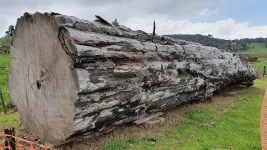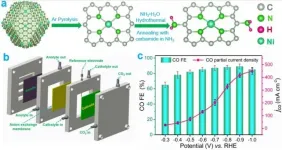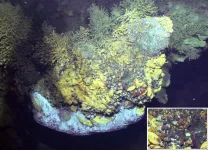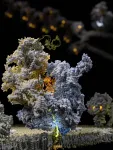(Press-News.org) The last complete reversal of the Earth's magnetic field, the so-called Laschamps event, took place 42,000 years ago. Radiocarbon analyses of the remains of kauri trees from New Zealand now make it possible for the first time to precisely time and analyse this event and its associated effects, as well as to calibrate geological archives such as sediment and ice cores from this period. Simulations based on this show that the strong reduction of the magnetic field had considerable effects in the Earth's atmosphere. This is shown by an international team led by Chris Turney from the Australian University of New South Wales, with the participation of Norbert Nowaczyk from the German Research Centre for Geosciences Potsdam and Florian Adolphi from the Alfred Wegener Institute, in a study that now appears in the journal Science.
The Earth's magnetic field undergoes permanent fluctuations and occasionally even reversals of polarity occur. Their causes, course and effects are not yet fully understood. Researchers have now investigated the so-called Laschamps event in more detail. It refers to the last complete reversal of the polarity of the Earth's magnetic field around 42,000 years ago. Not only did the magnetic field change direction, it also dramatically lost strength over a period of several hundred years.
About 42,000 years ago, the magnetic north pole moved south. Within this process, which lasted about 500 years, the magnetic field weakened to between six and zero per cent. During a period of about 500 years, the poles remained reversed, with a field strength that varied below 28 per cent of today's value, only to reverse again over the course of about 250 years.
This exact chronological classification is now possible by linking different data sets. Firstly, the researchers used results on the Earth's magnetic field from sediment cores of the Black Sea by Norbert Nowaczyk and his team from 2013, which were matched with Greenland ice cores via climate variation documented at the same time.
Secondly, the exact analysis and dating of the events was only made possible by the radiocarbon (14C) analysis of a sub-fossil kauri tree that grew in the wetlands of Ngawha in northern New Zealand for around 1700 years during the period in question and was subsequently very well preserved in the swamps.
Chris Turney had reported on this finding from about 40,000 years ago during a visit to the German Research Centre for Geosciences in Potsdam (GFZ) a few years ago. "As a geomagnetic scientist, I immediately had a link to the Laschamps event in mind and suggested 14C analyses, which had not yet been done on trees from that time," says Nowaczyk, who heads the Laboratory for Palaeo- and Rock Magnetism at the GFZ.
The background: With the dwindling of the magnetic field, the Earth is losing an important protective shield against cosmic radiation, at least in part. This is also reflected in increased levels of the radioactive carbon isotope 14C in the trees. The reason for that is the increased formation of 14C in the Earth's atmosphere during the bombardment of nitrogen by high-energy, electrically charged cosmic particles.
"The sub-fossil kauri trees are an exciting archive of atmospheric composition," says Florian Adolphi, palaeoclimatologist at the Alfred Wegener Institute, Helmholtz Centre for Polar and Marine Research (AWI). These trees can live for several thousand years and record annual variations in atmospheric radiocarbon content as they grow, which the research team measured precisely.
"These data improve the calibration curve for radiocarbon dating, allowing more accurate dating of a wide range of climate archives and fossils. They also allow a direct comparison to ice cores: beryllium isotopes measured there show similar variations to the radiocarbon in the trees, as the production of both isotopes in the Earth's atmosphere depends on the intensity of cosmic rays hitting the Earth," explains the study's co-author. He uses this effect to synchronise trees and ice cores with high precision and reduce the uncertainty of comparing the two archives from several thousand years to about 100 years.
To investigate further effects of the weak Earth's magnetic field on the atmosphere and thus also on the global climate, the researchers carried out simulations of atmospheric chemistry. Among other things, they found a decrease in ozone. "Unfiltered radiation from space was breaking up air particles in the Earth's atmosphere, separating electrons and emitting light - a process called ionisation," Turney explains. "The ionised air 'sizzled' the ozone layer." This triggered a wave of changes in the atmosphere, including increased dazzling light shows that we know as the aurora borealis, which at the time may have been observed not only near the poles but across the globe.
It is important to further analyse the effects of the weak magnetic field in this direction in view of current developments, says Nowaczyk. Because the Earth's magnetic field has already been weakening for about 2000 years. Compared to the first direct measurements 170 years ago, a weakening of nine per cent was observed, in the area of the South Atlantic even thirty per cent. Whether this means that a pole reversal is in the offing for the next one to two thousand years is debatable. However, a collapse of the natural radiation shield would pose a great challenge to our present-day society, which is very much based on electronics.
On the basis of these new possibilities for the chronological classification of the events 42,000 years ago, the main authors of the study put forward even more far-reaching hypotheses about the effects of the Earth's magnetic field reversal - for example with regard to the extinction of the Neanderthals or the onset of cave paintings. Nowaczyk does not rule out the possibility that there are causal connections here, but considers it rather unlikely.
INFORMATION:
Researchers at Tampere University have successfully used artificial intelligence to predict nonlinear dynamics that take place when ultrashort light pulses interact with matter. This novel solution can be used for efficient and fast numerical modelling, for example, in imaging, manufacturing and surgery. The findings were published in the prestigious Nature Machine Intelligence journal.
Artificial intelligence can distinguish different types of laser pulse propagation, just as it recognizes subtle differences of expression in facial recognition. The newly found solution can make it simpler to design experiments in fundamental research and will allow algorithms ...
Carbon dioxide (CO2) electrocatalytic reduction driven by renewable electricity can solve the problem of excessive CO2 emissions. Since CO2 is thermodynamically stable, efficient catalysts are needed to reduce the energy consumption in the process.
The single-atom catalysts immobilized on nitrogen-doped carbon supports (M-N/C) have been widely used for CO2 electrocatalytic reduction reaction due to their high atom utilization efficiency.
Recently, a research team led by Prof. LIU Licheng from the Qingdao Institute of Bioenergy and Bioprocess Technology (QIBEBT) of the Chinese Academy of Sciences (CAS) proposed a two-step amination strategy to regulate the electronic structure of M-N/C catalysts (M=Ni, Fe, Zn) and enhance the intrinsic activity of CO2 electrocatalytic reduction.
In ...
EUGENE, Ore. -- Feb. 19, 2021 -- Friction caused by dry Martian dust particles making contact with each other may produce electrical discharge at the surface and in the planet's atmosphere, according University of Oregon researchers.
However, such sparks are likely to be small and pose little danger to future robotic or human missions to the red planet, they report in a paper published online and scheduled to appear in the March 15 print issue of the journal Icarus.
Viking landers in the 1970s and orbiters since then detected silts, clays, wind-blown bedforms and dust devils on Mars, raising questions about potential electrical activity.
Scientists ...
China is just one of many countries in the Northern Hemisphere having what researchers are calling an "extremely cold winter," due in part to both the tropical Pacific and the Arctic, according to an analysis of temperatures from Dec. 1, 2020, to mid-January of 2021. A country-specific case study, the investigation potentially has far-reaching implications for predictions and early warnings to protect against harmful impacts, researchers said.
The results were published online, ahead of print, on Feb. 12 in Advances in Atmospheric Sciences.
"We are trying to explain why the countries in the Northern Hemisphere ...
Nanoparticles used in drug delivery systems, bioimaging, and regenerative medicine migrate from tissues to lymphatic vessels after entering the body, so it is necessary to clarify the interaction between nanoparticles and lymphatic vessels. Although technology to observe the flow of nanoparticles through lymphatic vessels in vivo has been developed, there has been no method to evaluate the flow of nanoparticles in a more detailed and quantitative manner ex vivo. Thus, research was conducted to develop an ex vivo lymphatic vessel lumen perfusion system to determine how nanoparticles move in lymphatic vessels and how they affect the physiological movement of lymphatic vessels.
Nanoparticles introduced into the ...
A research team led by Prof. QIAN Peiyuan, Head and Chair Professor from the Hong Kong University of Science and Technology (HKUST)'s Department of Ocean Science and David von Hansemann Professor of Science, has published their cutting-edge findings of symbiotic mechanisms of a deep-sea vent snail (Gigantopelta aegis) in the scientific journal Nature Communications. They discovered that Gigantopelta snail houses both sulfur-oxidizing bacteria and methane-oxidizing bacteria inside its esophageal gland cells (part of digestive system) as endosymbionts. By decoding the ...
A new study looking at how COVID-19 affects people with asthma provides reassurance that having the condition doesn't increase the risk of severe illness or death from the virus.
George Institute for Global Health researchers in Australia analysed data from 57 studies with an overall sample size of 587,280. Almost 350,000 people in the pool had been infected with COVID-19 from Asia, Europe, and North and South America and found they had similar proportions of asthma to the general population.
The results, published in the peer-reviewed END ...
Researchers at the University of Illinois Chicago have discovered a way to convert the methane in natural gas into liquid methanol at room temperature.
This discovery, reported in the journal Proceedings of the National Academy of Sciences, could potentially provide a cleaner energy source for many of our everyday activities.
When burned, natural gas -- the fuel used to heat homes, cook food and generate electricity -- produces carbon dioxide, a powerful greenhouse gas.
According to the U.S. Energy Information Administration, the U.S. consumed approximately 31 trillion cubic feet of natural gas in 2019, contributing roughly 1.6 gigatons of carbon dioxide to the atmosphere.
A better way to use natural gas would be to convert it to methanol, a liquid fuel that burns more ...
University of Queensland scientists have developed an ultraviolet 'television' display designed to help researchers better understand how animals see the world.
Until now, standard monitors on devices like televisions or computer screens have been used to display visual stimuli in animal vision studies, but none have been able to test ultraviolet vision - the ability to see wavelengths of light shorter than 400 nanometres.
Dr Samuel Powell, from the Queensland Brain Institute's Marshall lab, said this new technology will help unveil the secrets of sight in all sorts of animals, such as fish, birds and insects.
"Human TVs generally use three colours - red, green and blue - to create images, but our newly-developed ...
Mitochondria are organelles that act as the powerhouses in our body. They use oxygen which we inhale and food we eat to produce energy that supports our life. This molecular activity is performed by bioenergetic nano-factories incorporated in specialized mitochondrial membranes. The nano-factories consist of proteins cooperatively transporting ions and electrons to generate chemical energy. Those have to be constantly maintained, replaced and duplicated during cell division. To address this, mitochondria have their own bioenergy protein-making machine called the mitoribosome. Given its key role, a deregulation of the mitoribosome can lead to medical disorders such as deafness and diseases including cancer development. The first fundamental understanding of how mitoribosomes ...





